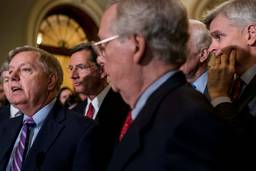The GOP Tax Plan Was Sold On a Baseless Theory. Now It’s Being Exposed As a Giveaway to the Rich.
Josh Bivens and Hunter Blair

On Tax Day, Republicans in Congress will surely be trying to tout the benefits from the Tax Cuts and Jobs Act (TCJA) that they passed in December. It’s still far too early to make big claims about what the data shows about the effect of the TCJA, but it’s worth remembering why we should be very doubtful that any benefits at all will accrue to typical American families from the largest — and only permanent — feature of the TCJA, the cuts in corporate income tax rates.
The TCJA’s likely effect on the economy depends on whether the economy remains demand-constrained or not. Below, we’ll lay out why the TCJA is bad policy regardless of whether or not today’s economy remains demand-constrained.
When the economy is demand-constrained, there is not enough overall spending in the economy — or “aggregate demand” — to pin the economy at full employment. If the economy still suffers from a lack of aggregate demand, as we believe is likely the case, then tax cuts can boost demand — and thereby employment — by increasing the post-tax income of households and businesses.
The TCJA is generally not defended on the grounds that it will boost demand. The reason why is clear: the tax cuts that make up the bulk of the TCJA — tax cuts for the rich and big corporations — are by far the weakest fiscal stimulus to aggregate demand. High-income households are more likely to save the money they receive from a tax cut than low- and moderate-income households. This means that much of the TCJA will end up as savings in the pockets of rich households rather than a boost to aggregate demand. Corporate tax cuts don’t rate any better on this core, for the same reasons. In the short run, the benefits of corporate tax cuts flow to shareholders. The top 1 percent owns 40 percent of total stocks. In short, corporate rate cuts are simply tax cuts for the rich by another name. Tax cuts for low- and middle-income households would have provided about three times as much bang for the buck as the TCJAs tax cuts for the rich and big corporations, as would have increases to income support programs or infrastructure spending.
All of this is why defense of the TCJA (and tax cuts for rich people generally) assumes the economy is not demand-constrained and is already at full employment. In this case, the claim is that cuts to the corporate rate give companies higher after-tax profits with which they can pay dividends to shareholders. This increases corporations’ incentive to undertake investment in new plant and equipment. And because the increase in the post-tax return to capital owners’ savings induces households to save more (or attracts more savings from abroad), these desired new investments can be financed without being choked off by rising interest rates. The resulting increase in capital investment gives workers more and better tools to work with, which boosts labor productivity and eventually wages.
This all makes sense in theory, but as we’ve long detailed, the real-world evidence doesn’t support that cuts to corporate income taxes will help typical American families. The reason for this in today’s economy is simple: post-tax returns to capital investment have been at historic highs for years now, yet capital investment lags. Increasing post-tax returns just does not seem to loosen any serious constraint on economic growth.
Even worse for the TCJA, however, is that the previous analysis assumes that these tax cuts to corporate income tax rates were paid for and do not add to the federal budget deficit. But as we all know now, the TCJA was not paid for. According to the Congressional Budget Office, the TCJA will add almost $1.9 trillion to deficits over 10 years. In the previous analysis, the boost to post-tax profit rates increased the incentive for private households to save, and this allowed new investments to be financed without pushing up interest rates. But for this to be true, it isn’t enough that just private savings increase — overall national savings must increase to keep interest rates from rising in the face of higher investment demand. The increase in federal budget deficits caused by the TCJA reduces public savings, and this would offset the effects of increased private savings. This means that if the economy genuinely is at full employment (as most TCJA proponents claim), then its failure to pay for the tax cuts will lead to higher interest rates that will choke off any investment incentive the TCJA provides.
There is simply no way to make a case that the TCJA was good economics relative to any plausible alternative. It has exceedingly low bang for the buck as a stimulus measure. Tax cuts that went disproportionately to low- and middle- income households, instead of to the rich and big corporations, or increases in government spending would have stimulated the economy by about three to five times as much. And once the economy is at full employment, any theoretical benefit that could have come from cutting corporate tax rates will likely be offset by the increased deficits caused by the TCJA.
This should make clear that economic theory doesn’t support claims made by supporters of the TCJA. As an example, since in the short-run the benefits of corporate rate cuts flow entirely to shareholders, recent corporate PR stunts centered on employee bonuses have nothing economically to do with the TCJA. Instead, as the theory shows, an economic defense of the TCJA must rest on capital investment.
Again, in theory the increased deficits caused by the TCJA will offset the benefits that corporate rate cuts could have had on investment. But teasing out the effect the TCJA has had on capital investment in practice is going to take more time, and more data. Early reviews were not inspiring as orders for nondefense capital goods fell in both December and January. March orders at least moved in the right direction for the tax cut’s proponents, but still don’t show any change in trend growth. Around the end of April, we’ll get a first pass at some quarterly data to start seeing what, if any, effect the TCJA is having on investment and other economic data. But even this will be tentative, and in the meantime there is no reason to think that the effects of the TCJA in practice will differ from what theory predicts.
This piece originally appeared at the Economic Policy Institute blog.






